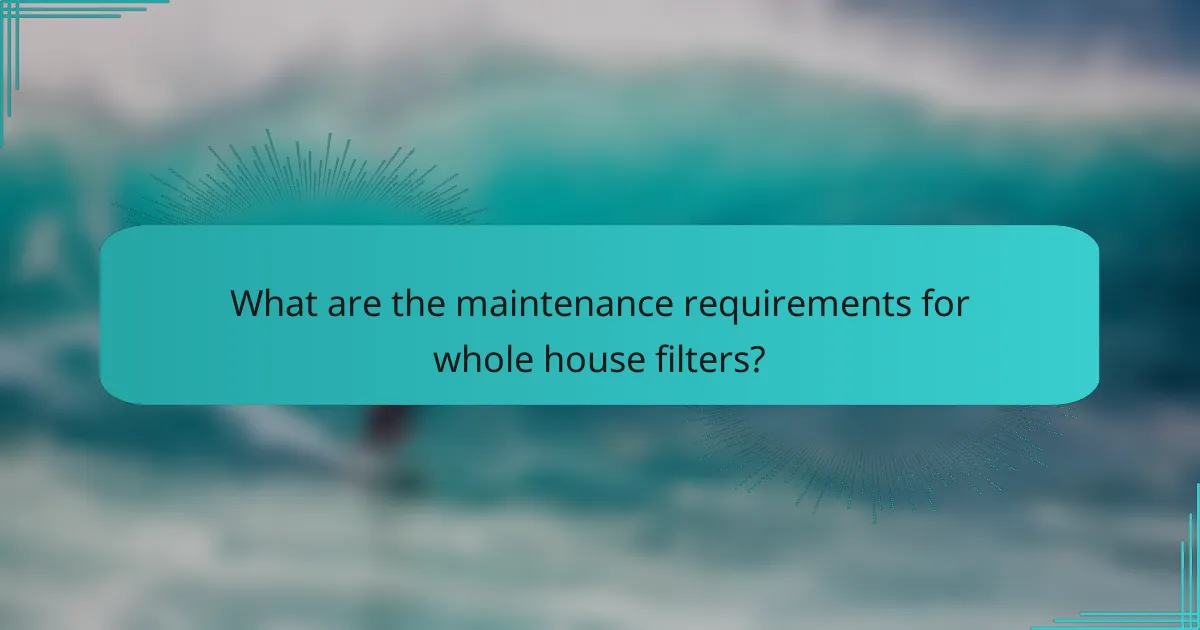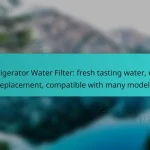Whole house filters are essential for ensuring clean and safe drinking water throughout your home, effectively removing contaminants from your water supply. When selecting a system, it’s important to consider the flow rate, as it impacts water delivery and pressure, especially during peak usage. Additionally, regular maintenance is necessary to keep the filter functioning optimally, which includes timely filter replacements and routine cleaning. Space considerations should also be taken into account to ensure the system fits well within your home environment.

What are the best whole house filters for UK homes?
The best whole house filters for UK homes effectively remove contaminants from water, ensuring clean and safe drinking water throughout the property. Key options include systems from Brita, Aquasana, and iSpring, each offering unique features and benefits tailored to different needs.
Brita Whole House Water Filter System
The Brita Whole House Water Filter System is designed to reduce chlorine, sediment, and other impurities, providing cleaner water for all household uses. It typically features a multi-stage filtration process that enhances taste and quality.
When considering this system, check the flow rate, which is generally adequate for average UK households. Regular maintenance is required, including filter replacements every six months, to ensure optimal performance.
Aquasana Whole House Filter System
Aquasana’s Whole House Filter System is known for its advanced filtration technology, which targets a wide range of contaminants, including heavy metals and chemicals. This system often includes a pre-filter, a main filter, and a post-filter to maximize purification.
Space considerations are important, as this system requires a dedicated area for installation, typically in basements or utility rooms. Maintenance involves changing filters approximately every six months to one year, depending on water quality and usage.
iSpring Whole House Water Filter
The iSpring Whole House Water Filter is praised for its comprehensive filtration capabilities, effectively removing chlorine, sediment, and other harmful substances. This system is suitable for various water sources, including well water and municipal supplies.
Installation requires sufficient space, as the system is larger than some alternatives. Regular maintenance includes replacing filters every six to twelve months, depending on the specific model and water conditions. Be mindful of local water quality to determine the best maintenance schedule.

How does flow rate affect whole house filters?
The flow rate of a whole house filter is crucial as it determines how quickly water can be delivered throughout the home. A higher flow rate ensures adequate water pressure and supply for multiple outlets simultaneously, while a lower flow rate may lead to reduced performance and water shortages during peak usage times.
Flow rate defined
Flow rate refers to the volume of water that can pass through the filter in a given time, typically measured in liters per minute (L/min) or gallons per minute (GPM). This metric is essential for assessing whether a filter can meet a household’s water demands effectively.
When selecting a whole house filter, consider both the maximum flow rate and the average flow rate required for daily activities, such as showering, washing dishes, and laundry. A filter that cannot handle the household’s peak flow rate may result in inadequate water pressure or slow delivery.
Recommended flow rates for UK households
For UK households, the recommended flow rate for whole house filters typically ranges from 10 to 20 L/min, depending on the size of the home and the number of occupants. Smaller homes may function well with lower rates, while larger families or homes with multiple bathrooms may require higher rates to ensure sufficient water pressure.
To determine the appropriate flow rate, consider the number of fixtures in your home. For example, a home with two bathrooms, a kitchen, and a washing machine may need a flow rate closer to the upper end of the range to accommodate simultaneous use without compromising performance.

What are the maintenance requirements for whole house filters?
Whole house filters require regular maintenance to ensure optimal performance and water quality. This includes timely filter replacements and routine cleaning to prevent clogs and ensure efficient operation.
Filter replacement frequency
The frequency of filter replacement for whole house systems typically ranges from every 6 months to 2 years, depending on water quality and usage. For households with high sediment levels or heavy water usage, more frequent changes may be necessary.
To determine the best schedule, monitor water clarity and pressure. If you notice a drop in water flow or an increase in sediment, it may be time to replace the filter sooner than planned.
Cleaning and upkeep tips
Regular cleaning of the filter housing and pre-filters can extend the life of your whole house filter system. Rinse out any sediment or debris that accumulates during use, and follow the manufacturer’s guidelines for cleaning procedures.
Additionally, check for leaks and ensure all connections are secure. Keeping the area around the filter system clean and accessible will make maintenance tasks easier and more efficient.

What space considerations should be taken into account?
When installing a whole house filter, it’s essential to consider the available space for both the unit and its necessary plumbing connections. Adequate space ensures proper installation, maintenance access, and efficient water flow.
Installation space requirements
Whole house filters typically require a dedicated area for installation, often near the main water line. The space should accommodate the filter’s dimensions, which can vary from about 2 to 4 feet in height and 1 to 2 feet in width. Additionally, allow for extra clearance around the unit for maintenance and potential future upgrades.
It’s advisable to check the manufacturer’s specifications for the exact space needed, as some models may require more room for additional components like pressure gauges or sediment tanks. Ensure that the installation area is dry and protected from extreme temperatures to maintain the filter’s efficiency.
Location options for filter systems
Common locations for whole house filters include basements, crawl spaces, or utility rooms, where they can be easily connected to the plumbing system. Choosing a location close to the main water supply minimizes the length of piping needed, which can help maintain water pressure and flow rate.
Consider accessibility for maintenance tasks when selecting a location. Avoid placing the filter in areas prone to flooding or extreme cold, as this can damage the system. If space is limited, wall-mounted options may be available, which can save floor space while still providing effective filtration.

How to choose the right whole house filter?
Choosing the right whole house filter involves evaluating flow rate, maintenance needs, and available space. Understanding these factors ensures you select a system that meets your household’s water quality requirements without compromising performance.
Factors to consider
When selecting a whole house filter, consider the flow rate, which should match your household’s water usage. Typical flow rates range from 5 to 20 gallons per minute, depending on the number of fixtures and occupants in your home.
Maintenance requirements are also crucial; some filters need regular cartridge replacements every few months, while others may last several years. Assess your willingness to perform maintenance and factor in the associated costs.
Space considerations are essential as well. Ensure you have adequate room for the filter system, including access for maintenance. Whole house filters can vary in size, so measure your installation area before making a decision.
Comparison of top brands
Leading brands in the whole house filter market include Aquasana, Home Master, and APEC. Aquasana offers systems with multi-stage filtration and a flow rate of up to 7 gallons per minute, making it suitable for medium-sized homes.
Home Master provides a high-capacity filter with a flow rate of around 15 gallons per minute, ideal for larger households. Their systems are known for easy maintenance and long-lasting filters.
APEC specializes in reverse osmosis systems, which are effective for removing contaminants but may require additional space and maintenance. When comparing brands, consider factors like warranty, customer service, and specific filtration capabilities to find the best fit for your needs.

What are the costs associated with whole house filters?
The costs associated with whole house filters include initial purchase prices and ongoing maintenance expenses. Understanding these costs is crucial for budgeting and ensuring the system remains effective over time.
Initial purchase costs
The initial purchase costs for whole house filters can vary significantly based on the type and capacity of the system. Basic models may start around $500, while advanced systems with additional features can exceed $2,000. Installation costs, which can range from $200 to $1,000, should also be considered when budgeting.
When selecting a system, consider the flow rate and filtration capacity to ensure it meets your household’s needs. Higher capacity systems typically have higher upfront costs but may offer better long-term value through enhanced performance.
Long-term maintenance expenses
Long-term maintenance expenses for whole house filters generally include replacement filters and periodic servicing. Replacement filters can cost between $50 and $300 annually, depending on the type of filter and the frequency of replacement. Some systems may require filter changes every 6 to 12 months.
In addition to filter replacements, consider potential service costs for system checks or repairs. Regular maintenance can help prevent costly issues and extend the lifespan of the system, making it a worthwhile investment.

What are the benefits of whole house filters?
Whole house filters provide comprehensive water purification for every tap in your home, ensuring clean and safe water for drinking, cooking, and bathing. They help remove contaminants such as chlorine, sediment, and heavy metals, improving both water quality and taste.
Flow Rate
The flow rate of a whole house filter is crucial as it determines how quickly water can be delivered throughout your home. Most systems offer flow rates ranging from 5 to 20 gallons per minute (GPM), which is typically sufficient for average household needs.
When selecting a filter, consider your household size and peak water usage times. For instance, larger families or homes with multiple bathrooms may require a higher flow rate to ensure adequate water pressure during simultaneous usage.
Maintenance Requirements
Regular maintenance is essential for optimal performance of whole house filters. This often includes replacing filter cartridges every 6 to 12 months, depending on usage and the type of contaminants being filtered.
Additionally, periodic system checks can help identify any issues before they become significant problems. Keeping a maintenance schedule can prevent costly repairs and ensure your water remains clean and safe.
Space Considerations
Whole house filters require adequate space for installation, typically in basements, garages, or utility rooms. Ensure you have enough room for the filter unit itself, as well as for any necessary plumbing connections and future maintenance access.
Before purchasing, measure the installation area to confirm that the chosen system will fit comfortably. Consider the height and width of the unit, as well as any additional space needed for maintenance tasks.


